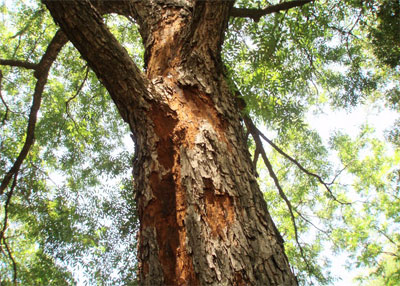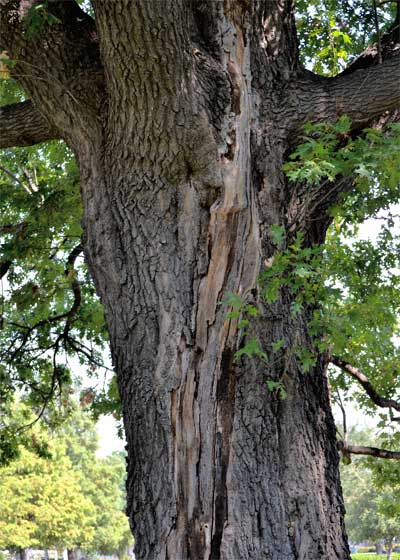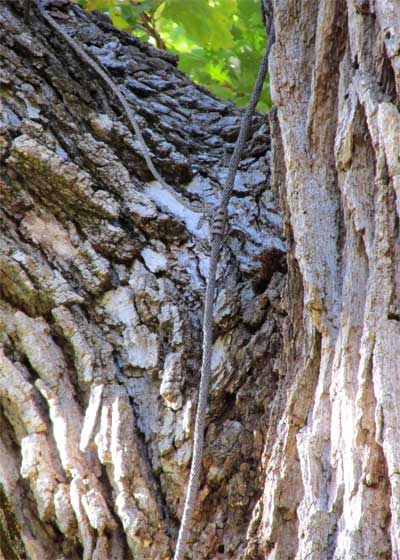Texas Tree Tips: December 2013

A direct lightning strike to this mature pecan tree has blown the bark off the trunk and limbs, leaving a trail of the electrical path through the tree. Photo by Bill Seaman.
Lightning Damage to Trees
by Steve Houser
If you own a large or tall tree that stands alone on a hill or out in the open, it is at a much greater risk of being struck by lightning. A medium-sized tree or trees surrounded by others growing in a forest are at less risk. If a tree falls in the first category, or if it is a historic, heritage, champion, or specimen-quality tree, it is wise to consider installing a lightning protection system.
Lightning can instantly kill a tree by shocking it with up to 100 million volts of electricity, which literally cooks the vascular system of the tree with heat of up to 50,000 degrees Fahrenheit. The cells become instantly super-heated, and this causes the bark to peel or explode and be blown off the tree, typically in a streak from the upper canopy down the trunk to the ground. The damage can also extend to roots under the ground, creating further concern regarding the roots’ ability to offer structural support for the trunk and upper canopy. You would have a hard time standing as well — if your feet were burnt to a crisp.

The old lightning strike wound on this red oak provides a portal for damaging insects and fungal diseases. Photo by Bill Seaman.
In some cases, the foliage quickly turns brown and the tree dies after a lightning strike. In other cases, the streak of damage to the vascular system is localized and may not kill the tree. However, there are instances where lightning weakens the tree’s defenses, and insects — primarily wood borers — as well as pathogens, slowly kill the tree over a period of a few years.
At first, the full extent of the damage may be hidden, but then becomes more apparent as time goes on. It can take months or years before the full effects of a lightning strike become apparent. In some cases, the best action at first is no action other than patient observation.
Assuming the tree has a chance to survive, loose bark may be removed, along with limbs that appear to be structurally weak. Other tree health-care-related actions may be taken, but it depends greatly on the specific damage found on a tree and its current prognosis.

The lighting protection system in this historic bur oak tree helps protect it from lightning damage. Large trees with canopies that reach above those of surrounding trees are natural lighting rods. Photo by Steve Houser.
Large and valuable trees at risk of lightning strikes can be protected from lightning damage by installing a lightning protection system. The system consists of copper wires and ground rods that act to carry the electrical charge from lightning to the ground before it reaches a damaging level to a tree. Trees, in essence, are standing vessels of water that act as ground rods for lightning. Since copper is a much better conductor of electricity than water, lightning travels through the copper wires and spares the tree from damage.

The bright copper from newly installed lightning protection systems quickly dulls and blends in with the color of tree trunks and branches when exposed to the weather. Photo by Bill Seaman.
Lightning protection systems must be designed for the specific branching habit of each individual tree. The proper hardware includes “points” at the top of each major limb with wires that run down the trunks. The wires often join together and then run outward to ground rods driven several feet into the ground.
The copper system is costly, but the loss of a large or significant tree can exact an emotional as well as financial toll on the tree’s owner. Also, consider that a large old tree cannot be replaced in our lifetime — for all the money in the world!

